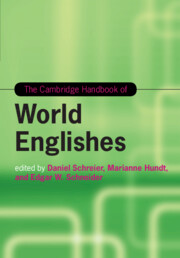Book contents
- The Cambridge Handbook of World Englishes
- Cambridge Handbooks in Language and Linguistics
- The Cambridge Handbook of World Englishes
- Copyright page
- Dedication
- Contents
- Figures
- Maps
- Tables
- Notes on Contributors
- 1 World Englishes: An Introduction
- Part I The Making of Englishes
- Part II World Englishes Old and New
- Part III Linguistics and World Englishes
- 14 The Global Growth of English at the Grassroots
- 15 Beyond English as a Second or Foreign Language: Local Uses and the Cultural Politics of Identification
- 16 World Englishes in Cyberspace
- 17 World Englishes and Their Dialect Roots
- 18 Lexicography and World Englishes
- 19 The Relevance of World Englishes for Variationist Sociolinguistics
- 20 Multilingualism and the World Englishes
- 21 Unearthing the Diachrony of World Englishes
- 22 Corpus-Based Approaches to World Englishes
- 23 World Englishes from the Perspective of Dialect Typology
- 24 Language Acquisition and World Englishes
- Part IV Current Challenges
- Index
- References
24 - Language Acquisition and World Englishes
from Part III - Linguistics and World Englishes
Published online by Cambridge University Press: 16 December 2019
- The Cambridge Handbook of World Englishes
- Cambridge Handbooks in Language and Linguistics
- The Cambridge Handbook of World Englishes
- Copyright page
- Dedication
- Contents
- Figures
- Maps
- Tables
- Notes on Contributors
- 1 World Englishes: An Introduction
- Part I The Making of Englishes
- Part II World Englishes Old and New
- Part III Linguistics and World Englishes
- 14 The Global Growth of English at the Grassroots
- 15 Beyond English as a Second or Foreign Language: Local Uses and the Cultural Politics of Identification
- 16 World Englishes in Cyberspace
- 17 World Englishes and Their Dialect Roots
- 18 Lexicography and World Englishes
- 19 The Relevance of World Englishes for Variationist Sociolinguistics
- 20 Multilingualism and the World Englishes
- 21 Unearthing the Diachrony of World Englishes
- 22 Corpus-Based Approaches to World Englishes
- 23 World Englishes from the Perspective of Dialect Typology
- 24 Language Acquisition and World Englishes
- Part IV Current Challenges
- Index
- References
Summary
Language acquisition and World Englishes (WEs) research are two subdisciplines with their own theoretical approaches, classifications, terminologies, and methodologies for investigation. They also have distinct perspectives on otherwise similar phenomena, viz. manifestations of acquiring/learning a language. As early as 1986, Sridhar and Sridhar discerned “a lack of articulation between theories of SLA and research on the acquisition and use of IVEs [indigenized varieties of English]” (Sridhar and Sridhar 1986: 12) and prompted an integrated approach. However, this call remained largely unheard for about twenty years. Only quite recently have studies pointed to potential similarities and the connectedness of learner Englishes and WEs as well as the possibility, if not necessity, of an integrated approach to the two objects of inquiry. The current chapter provides a scholarly review of these developments. It starts out with a summary and discussion of the potential and need for an integration of the Second Language Acquisition and WEs research paradigms, ultimately expanding the focus to a joint treatment of WEs and First Language Acquisition research.
Keywords
- Type
- Chapter
- Information
- The Cambridge Handbook of World Englishes , pp. 559 - 584Publisher: Cambridge University PressPrint publication year: 2020
References
- 1
- Cited by



